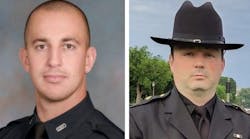Planning for the inaugural "Summit on the Impact of California's Medical Marijuana Laws," organizers worried no one would show up. But when the summit took place this spring, there were more than 400 attendees. The law enforcement-only event was sponsored by the California Department of Justice, the California Police Chiefs Association (CPCA), the California Peace Officers' Association and the California State Sheriffs' Association.
California, the first state to legalize medical marijuana in 1996, continues to learn from its experiences. With a dozen other states following their lead and passing medical marijuana laws, and more states looking to do the same, eyes remain focused on The Golden State.
El Cerrito Chief Scott Kirkland, who helped organize the summit and found CPCA's Medical Marijuana Dispensary Task Force, says law enforcement must acknowledge that marijuana decriminalization is a growing issue nationwide. Kirkland says there are issues law enforcement must take a stand on, and one of them is marijuana, which, according to the National Drug Intelligence Center National Drug Threat Assessment 2009, is abused more than any other drug.
"California is a great example of what not to do," says Kirkland, a member of CPCA's board of directors and a veteran of El Cerrito law enforcement since 1979.
As a police chief, he accepts some of the blame. "We've done a poor job getting the word out about the dangers associated with marijuana use," he explains.
Today's marijuana
Politicians are suggesting decriminalization should be up for debate, but often they have little knowledge of the topic, says Kirkland. Today's politicians, along with others in positions of responsibility, may have smoked marijuana in the '60s and '70s and "never inhaled" — or inhaled, because "that was the point."
Either way, many of them think today's marijuana is the same relatively harmless drug they tried in high school or college, Kirkland says, but it's not. In May, the Office of National Drug Control Policy released analysis from the University of Mississippi, which revealed THC — the psychoactive ingredient in marijuana — reached the highest levels since the drug was first analyzed. According to the analysis, the average amount of THC in samples confiscated by law enforcement agencies in 2008 was 10.1 percent, compared to less than 4 percent in 1983. The highest concentration of THC in a single sample was 27.3 percent. The Potency Monitoring Project has analyzed seized samples since 1976 and is funded by the National Institute for Drug Abuse (NIDA).
According to NIDA, heavy marijuana use impairs a person's ability to form memories, recall events and shift attention. THC also disrupts coordination. Through its effects on the brain and body, marijuana intoxication can cause accidents. Studies have shown that about 6 to 11 percent of fatal accident victims test positive for THC. In many of these cases, alcohol also is detected.
And, since June 19, marijuana smoke is listed under Proposition 65 as known to cause cancer.
California's story
Advocates of decriminalizing marijuana have portrayed people in wheelchairs needing marijuana to relieve chronic pain from cancer, glaucoma and AIDS.
"I don't believe there's a police chief anywhere who wouldn't be sympathetic to people who have pain because of a disease," Kirkland says, but he adds research from the task force shows that patients with cancer, glaucoma and AIDS make up only about 2 percent of the people getting prescriptions filled at local marijuana dispensaries.
More likely, task force data presented at the summit show patients are going to the dispensaries because they have a prescription to help them with muscle spasms, insomnia, back pain, post-surgical pain or headaches.
While some sales are legal, some are not. An Internet post describes, "I got my prescription about a week ago, and it was the easiest thing I've ever done."
A physician's statement raises the question how much marijuana is enough.
The note says, "This patient uses marijuana topically, which greatly increases his need. It is recommended that this patient be allowed to have up to 75 marijuana plants growing and up to 5 pounds of dry marijuana."
The task force also referenced a 2008 Santa Barbara County Civil Grand Jury report on medical marijuana dispensaries which concluded some facilities are largely unregulated:
- Few restrictions exist to prevent patients from purchasing large amounts of marijuana in several shops.
- Inventory and sales records are not accurately maintained.
- The average cost for an ounce is $350 to $600. Dispensary owners reported the average amount sold at one time is 1/8 of an ounce, which could last a day or a month, depending on patient use.
At the summit, El Cerrito Commander Michael Regan outlined more problems: He states there is currently no process to obtain a dispensary license, nor is there an approval or licensing entity. Additionally, he notes very few, if any, restrictions exist.
For that reason, it's difficult to know how many dispensaries there are in California; One common estimate is 600. Crime related to dispensaries is often not reported, Regan says. Likely, the industry fears prosecution or doesn't want a bad name, he says. If crimes are reported, they may not be recorded as "dispensary-related," and he says some cities and agencies just do not want to discuss the issue.
Sharing data with the task force, the Los Angeles Police Department reported that while most other areas of Los Angeles experienced reductions in Part I crime, areas near marijuana dispensaries experienced a 200-percent increase in robberies, a 52-percent increase in burglaries, and a 57-percent increase in aggravated assaults.
With large amounts of marijuana and cash on hand, dispensaries and their customers are targets for crime.
Starting the fight
Unfortunately, law enforcement isn't always asked to weigh-in on a debate like decriminalization, even when public safety is directly impacted. When the El Cerrito City Council passed the first reading of an ordinance to allow medical marijuana dispensaries, Kirkland says no one asked him how the ordinance would affect public safety. But after sitting speechless during one council meeting, he decided he had to do something. At the next council meeting, he and Regan made a presentation on the secondary effects of marijuana. As a result of this report, the council on July 16, 2006, passed an ordinance banning marijuana dispensaries in the city of about 24,000 people.
And, Kirkland and Regan haven't stopped telling others about the dangers of marijuana. After he and Regan made a presentation to the CPCA, a medical marijuana dispensary task force was formed by the CPCA, California State Sheriffs' Association, narcotics officers' and district attorneys' associations, and the California Highway Patrol. The task force was formed to address state versus federal law enforcement issues as well as crime and quality of life issues.
Kirkland is often asked by news media if the war on drugs has been lost.
His response is: "No, I do not believe we have lost the war, I believe we have started the fight."
Creating a network
Advocates of drug decriminalization are often well-funded, and they understand marketing and politics. Police chiefs, sheriffs and others in law enforcement can be leaders, but they need help, Kirkland says.
Educating Voices Inc., a non-profit national organization founded to help people avoid the dangers of drugs, has been a resource for the task force. EVI President Judy Kreamer agrees building a network is crucial. She says that's one of the reasons Illinois has been successful at opposing medical marijuana — EVI has worked closely with law enforcement and others.
"Law enforcement is known for leading, for being concerned for the welfare of others," Kreamer says. "I think law enforcement needs to market that more."
Law enforcement shouldn't have to be responsible for drug prevention, she says, but often no one else is taking the responsibility and telling the stories of what drugs do in real life.
"It's all about educating, but you have to have a nucleus, and that nucleus has to reach out and bring other groups on board," she says. For the first time this year a medical marijuana measure passed in the Illinois State Senate, but it hasn't gone through the House.
"We never know if we're going to win or not," Kreamer says. "That's why we keep reaching out and building a stronger network." As one man who went first to his city council, then to his state police chiefs association and others in the state and nationwide, Kirkland feels law enforcement is gaining momentum.
"The more people we can get involved, the louder our voices will be heard," he says.
In this instance, California is a good example.
Rebecca Kanable is a freelance writer specializing in law enforcement topics. She can be reached at [email protected].



